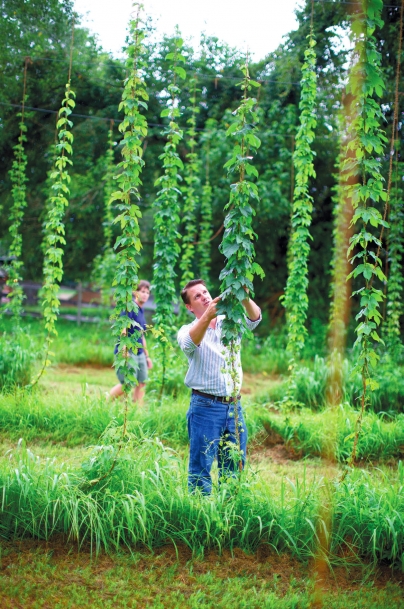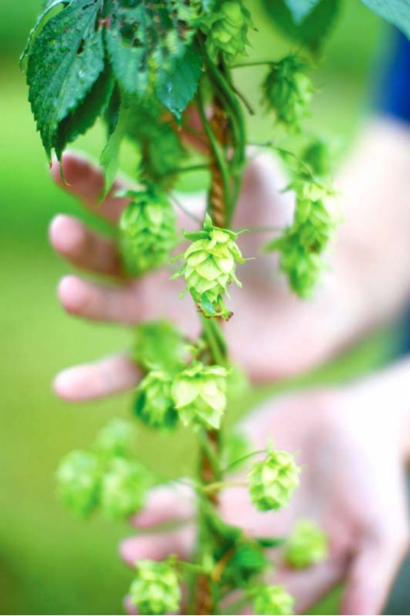Jersey Hop Farms
Taking Root
On a fair yet windy day in March of 1621, a lesser chief of New England's Abenaki people approached Plymouth Plantation on foot. He wore his hair long and was clothed in buckskin moccasins and a simple loincloth. His name was Samoset, and after greeting an armed group of Puritan men with a friendly "Welcome," he asked for a beer.
By this time, the Jamestown settlers in Virginia had already been drinking ale (albeit intermittently) for more than a decade, and European fishermen working along the coast of Maine had probably introduced the Abenaki and other Algonquian tribes to beer before that. Meanwhile, on the island of Manhattan, two Dutch colonists had begun brewing in 1612, and at least one historian contends that the English Quakers who established Salem in New Jersey in 1675 made the construction of a brewery a priority.
Among the challenges faced by the first generations of American brewers was obtaining ingredients. Yeast would not be fully understood until the 19th century, so early breweries needed only to concern themselves with water, barley, and hops. At least initially, malted barley had to be imported, but hops, the more fragile flavoring and stabilizing agent used in beer since at least the ninth century, were another issue. Lacking the ability to process or refrigerate the cone-shaped flowers that contain the valuable acids and oils, colonial brewers would have turned to more abundant ingredients like spruce tips to stand in for their bittering agent of choice.
Thought to originate in Mongolia or northern China, Humulus lupulus has existed for millions of years, and also grows wild in Europe and North America. This fact proved fortuitous for thirsty European immigrants, but native hops were in short supply in the New World. In the long run, cultivating this fast-growing perennial would be the solution to their problem. Historical records indicate that the Massachusetts Bay Company introduced European hops to North America in 1629, and that the Dutch began propagating them in the Hudson Valley soon after. By the 19th century, New York State had become the center of commercial hop growing, with annual production eventually peaking at about 20 million pounds. Evidence of large-scale hop growing in New Jersey is sketchy at best, however, with the state's humid climate and sandy soils likely hindering any widespread cultivation.
"As of 1880, national agricultural statistics show no hops grown in New Jersey," says Steve Miller, a hop specialist with the Cornell Cooperative Extension of New York's Madison County. "That seems unlikely, however. There may have been a very small acreage."
Small acreage or not, this specialty crop didn't have long to catch on before the industry moved west to Idaho, Oregon and Washington – the three states that now lead the nation in hop growing. Yet two centuries after commercial production really took off on the eastern seaboard, small-scale hop farming has returned to the Northeast, aided by agricultural advancements and the enthusiasm of a craft-beer community that has rapidly expanded in the last decade. Across the country, breweries continue to open at a rate of nearly one per day. While the pace is somewhat slower in New Jersey, fledgling beer businesses are hardly a rarity these days. The Garden State Craft Brewers Guild now contains 21 members, up from 16 in 2010. And this number doesn't even represent the total number of breweries and brewpubs in New Jersey, a figure that's closer to 40 when you include those still in a start-up phase or currently brewing off-site.
This development, especially when combined with a sustained public interest in food miles and eating local, has paved the way for a handful of small farmers eager to diversify their crop selection and meet the needs of an expanding market. Michael Visgil and his wife Sarah Puleo are one such family of part-time farmers. Growing hops is a second job for these newlyweds, and while they haven't started to work with breweries yet, they see potential in the small plot they planted in Southampton.
"We see this as just another possible way to bring the ever-growing, ever-evolving brewing community together," says Visgil of their Isaac Budd Farm, a piece of property named after an 18th-century landowner. "Perhaps for some this means gaining a sense of terroir with regard to their brewing ingredients. We decided to start hop farming to give ourselves and others access to locally grown ingredients for their beers. Hops, though very labor-intensive during harvesting, are a prolific crop if taken care of – paying mind to the downy and powdery mildews that drove this crop westward, of course."
With advice and assistance from the Northeast Hop Alliance, a nonprofit organization created to promote commercial hop production, as well as information collected from the University of Vermont and the Rutgers NJAES Cooperative Extension, Visgil and Puleo started off with just a third of an acre, choosing to focus on the popular and high-yielding Cascade and Nugget varieties for the bulk of their first crop last year. By comparison, the big growers in the Pacific Northwest represent a combined area in excess of 30,000 acres. Brewers, both hobbyists and professionals, have come calling though, and as Isaac Budd expands and their field matures (hop roots can survive and regenerate healthy plants for as long as a decade), demand will likely increase. In the meantime, Visgil and Puleo – who are home brewers themselves – admit they have more to learn.
"We're taking the necessary time to use the hops for our own brewing purposes, as well as trying to work around our extremely busy schedules," Visgil acknowledges. "This year we want to begin getting involved with home brewers, home-brew shops and some smaller breweries."
Elsewhere in the state, Beau Byrtus and his two partners at the Oast House Hop Farm already expect twice the yield from their secondyear plants, and intend to supply Kane Brewing Company of Ocean with fresh cones for another wet-hopped beer (that is, beer made with fresh, rather than dried, hops), something they successfully accomplished last fall. Like Visgil and Puleo at Isaac Budd, they started off with Nugget and Cascade plants. Kane founder and president Michael Kane called that first batch of beer impressive, even if it was necessarily small.
"If I remember correctly, we only got around ten pounds of Cascades last year," he says. "It was their first year so the harvest was limited."
Byrtus, who like his Oast House cofounders Marylu Hansen and Art Rhea hasn't left his full-time job, firmly believes that demand for locally sourced, quality brewing ingredients is rising. After tending a mere quarter-acre in 2012, the partners nearly quadrupled the size of their hop yard this spring, and Byrtus thinks Oast House will eventually be able to supply a number of different customers throughout New Jersey. And with 12 acres to work with in Wrightstown, the trio plans to continue expanding their farm incrementally. With help from family and a few friendly volunteers, they added Centennial, Columbus and Chinook rhizomes to their property and so will harvest five hop varieties this year. They also introduced a CSA (community-supported agriculture) program, earmarking 200 plants, or approximately one-third of their total crop, for it.
"Because we are small it will be difficult to provide for everyone, but we're constantly looking to different avenues for growth," Byrtus says. "Mike [Kane] and Glenn [Lewis, vice president of Kane Brewing] have been big proponents of the hop farm and are really fun to work with. In our second year we have been talking with several other breweries, and we've created a CSA model in an attempt to put locally sourced hops into the hands of home brewers while maintaining a portion of the crop for the craft market."
Even with a growing market for hops, one obstacle must be addressed in order for the industry to succeed in New Jersey: processing. Currently, Oast House only sells "wet" or fresh hops, which means Byrtus, Hansen and Rhea (plus any recruits) must work quickly to get everything out of their hop yard within 24 hours of harvesting. They could supply dried whole-leaf hops, but most breweries around the state – and, for that matter, across the country – work with pelletized hops. These dried, shredded and compressed little cylinders are easier to transport and store, and tend to be less susceptible to spoilage. To create them though, hops must be carefully dried, milled and packaged in an exacting series of steps that require specialized equipment – equipment that adds thousands of dollars to a farmer's initial investment. All of which is necessary to produce the uniform, quality product that brewers want.
"Recipe design and consistency are of the utmost importance," explains Visgil. "Though it is a novel concept to use hops grown in this region, the fact remains that there will be increased difficulty to produce a consistent product time after time. For some brewers, this might not be a problem, but for others, hops without the appropriate amount of alpha acids [which contain the plant's main bittering compounds] may induce a wildly different product from the last time."
Byrtus remains optimistic, however, and envisions a day when regional variations among hops will be increasingly discernible – and desirable – in craft beers.
"As small hop farms begin to expand there will be a more discernible difference in regional terroir," Byrtus says. "Where I think it will be most noticeable is in the wet hopped beers. And as people become more aware of craft beer's rich flavors, the demand for hops will grow."









